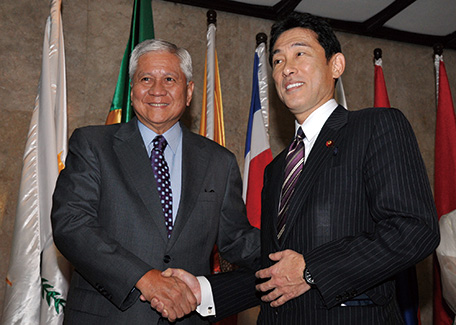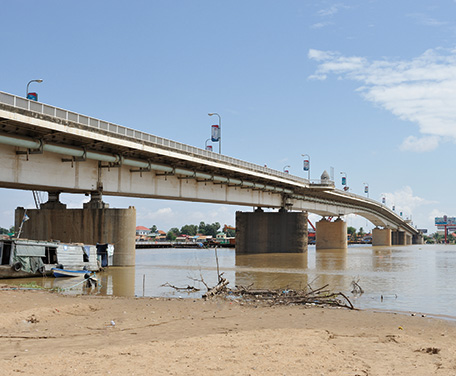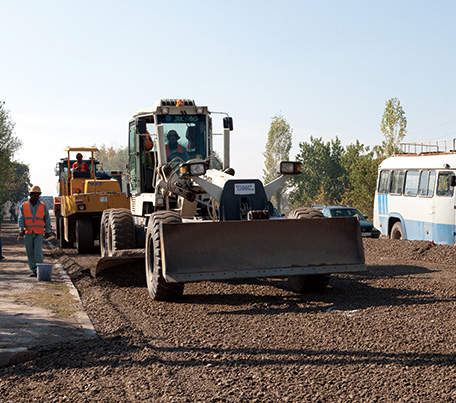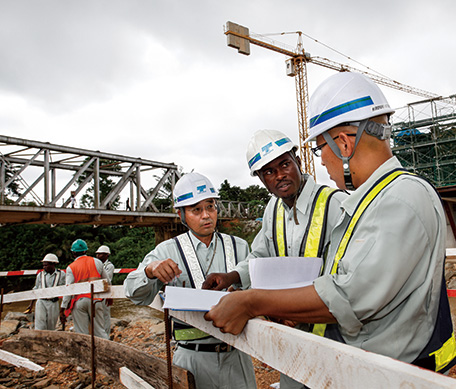Japan's Official Development Assistance White Paper 2012
Section 3 Contributing to Development by Exporting Infrastructure
To reduce poverty in developing countries, in addition to responding to Basic Human Needs (BHN), it is also important to achieve sustainable economic growth and stable employment. At international forums such as the G8 and G20, a wide consensus can be seen on the importance of developing socio-economic infrastructure that supports economic activities such as a transport network for products and raw materials and an electrical power supply, which is necessary to operate factories. The importance of revitalizing trade and investments through this development is also agreed upon. This vigorous demand in emerging and developing countries presents a large business opportunity for Japanese companies. Thus, the public and private sectors in Japan have been actively collaborating in an effort to expand infrastructure-related industry on an international level. The mobilization of private sector funds and technology to build infrastructure in developing countries also provides many benefits for the economy of those countries. The promotion of foreign direct investment will bring diverse results such as the creation of new industries, highly developed industries through technology transfer, and the promotion of employment.
In terms of the Japanese economy, building infrastructure for developing countries will lead to the improvement of the investment environment for Japanese companies while incorporating the demands of growing overseas markets. In regions where expectations for investment opportunities for Japanese companies have increased, the Japanese government is cooperating for the development of transport networks including roads, bridges, railways, ports, and airports. Additionally, cooperation is conducted for the stable supply of electricity using Japan’s superior technology for high-efficiency thermal power plants, for information and communication technology (ICT) for disaster risk reduction, etc. At the same time, cooperation for the development of legal systems and for building capacity in customs procedures is essential to improving the investment environment.
When there is trade between countries, the geographical distance between the countries is proportional to the incurred logistics costs. In general, the more distance there is between countries, the lesser the trade volume. However improving transport infrastructure can decrease transport time and increase volume, thereby making more active trading possible. Since economic integration is fostered by increasing the distribution volume between physically separated economic zones, further revitalization of trade can be expected. This economic integration is also effective in reducing disparities within region.

Minister for Foreign Affairs Fumio Kishida meets with Secretary of Foreign Affair Del Rosario in the Philippines where they agreed to cooperate for infrastructure development and for expanding trade and investment through development of the business environment.
Japan cooperates for developing infrastructures over a wide area around the world such as economic corridors* and is working toward achieving economic growth for developing countries through the revitalization of trade within the region. At the Japan-ASEAN Summit Meeting held in November 2011, Japan remarked on the necessity of using ODA to implement a list of flagship projects for enhancing regional connectivity, with the total project costs estimated at approximately ¥2 trillion. In addition, at the Fourth Tokyo International Conference on African Development (TICAD IV) Follow-up Meeting held in 2012, Japan pointed out the importance of infrastructure development to match the rapid growth in Africa, and announced that continued support will be provided, including development of the infrastructure to accelerate growth in Africa. In order to support the development of infrastructure in developing countries, Japan will continue to use ODA in various forms in the future.
To further build infrastructure in developing countries, partnering with the private sector is essential. To meet these new policy needs, existing systems are being improved and new systems are being introduced for Japan's ODA. In order to utilize the knowledge, experience, finances, and technologies of private companies while also supporting their expansion overseas, JICA began a program in FY 2010 for accepting proposals from private companies for Preparatory Surveys on public-private partnership (PPP)* Infrastructure Projects, and then commissioning the execution of the surveys to the proposing companies. Thus far, 26 projects have been selected (as of December 2012) and many companies are working on the formation of infrastructure ODA projects.
The JICA Private-Sector Investment Finance* system provides financing and loans directly to private sector projects that contribute to growth in developing countries. This system was fully resumed in October 2012 after appraisals, etc. were conducted for projects, including infrastructure projects, using a pilot approach and the implementation system was verified. As the first project after full resumption of Private Sector Investment Finance, a loan contract was signed for the "Utility Management of Environment-Friendly Industrial Parks and Water Supply Project" in Long An Province, Viet Nam on January 30, 2013.
This project is targeted for industrial parks in Long An Province in the rapidly industrializing Viet Nam. Here, the technology and expertise of Japanese companies will be used to implement waste water treatment within the industrial parks and to provide services for the development, operation, and maintenance of electrical power supply facilities. This will be done to promote industrial parks that are also environmentally friendly. This project will serve as a model case for PPP, and it is expected that PPP will continue to advance in the field of infrastructure.
In addition to the full resumption of the Private Sector Investment Finance program as mentioned above, the strategic use of ODA loans is also important as a part of strengthening public finance assistance. Efforts are being made to facilitate ODA loan procedures and to use these loans in a flexible manner for upper-middle-income countries and developing countries that exceed the income level of upper-middle-income countries.
Moreover, efforts are being made by METI in the area of technical cooperation to provide assistance in developing global human resources and for strengthening networks in partner countries. This is done through training programs for company personnel in partner countries to increase their understanding of Japanese infrastructure technology. Additionally, human resources based in the partner country are developed to ensure the cost competitiveness that is essential for Japanese companies to accept orders for infrastructure projects, and young Japanese personnel are dispatched to infrastructure-related government agencies, etc.

The Chruoy Changvar Bridge running through Phnom Penh is often called the "Japan Bridge" and was restored with Japan's ODA. (Photo: Koji Sato/JICA)

The growing city of Ho Chi Minh. Overlooking the Saigon East-West Highway and tunnel. (Photo: Hikaru Nagatake/JICA)

Construction site of the national road connecting the border of Afghanistan with the capital of Tajikistan. (Photo: Shinichi Kuno/JICA)

Repair work on a national road. Engineers from Japan and Ghana check progress at the site of bridge construction. (Photo: Akio Iizuka/JICA)
- *Economic Corridor
- Refers to the group of projects that include not only the development of physical infrastructure such as roads and bridges, but also the more intangible infrastructure aspects such as the simplification of customs clearance procedures. These projects are intended to extend the benefits of development to the growth of industry along the corridor and the improvement of the lives of the people. The aim is to revitalize the economy through an overall improvement of the distribution infrastructure to increase the transport volume between regions. Specific examples include the East-West Economic Corridor which connects the Mekong regions from Myanmar through Thailand and then to Laos and Viet Nam, as well as the Southern Economic Corridor, which extends from Bangkok, Thailand through Cambodia to Ho Chi Minh City, Viet Nam.
- *PPP (public-private partnership)
- A new method of cooperation in which governmental ODA projects are conducted in collaboration with private investing projects. Input from private businesses is incorporated at the formation stage of the project. For example, basic infrastructure is developed with ODA, while investing and operations/maintenance is conducted by the private sector. In this manner, roles are divided between the public and private sectors. The technologies, knowledge, experience, and funds of the private sector are then used in an effort to implement projects that are more efficient and effective, as well as to improve development efficiency.
(Areas for PPP: Water and sewer systems, airport construction, motorways, railways, etc.) - *JICA Private-Sector Investment Finance
- For this ODA loan, JICA provides the loans or financing necessary for development projects that are implemented by Japanese private sector companies in developing countries. These projects lead to economic revitalization and create employment, but since there are various risks involved and large profits cannot be expected, sufficient funds cannot be obtained from private financial institutions. Through providing loans and financing by Private-Sector Investment Finance for these projects, assistance is conducted for growth in developing regions. Areas eligible for assistance are (i) MDGs and poverty reduction, (ii) infrastructure and rapid growth, and (iii) climate change countermeasures. While ODA loans are a part of economic assistance given to the governments of developing countries, Private-Sector Investment Finance contributes to development by providing support for activities that are conducted by Japanese private companies together with the private companies of developing countries.
